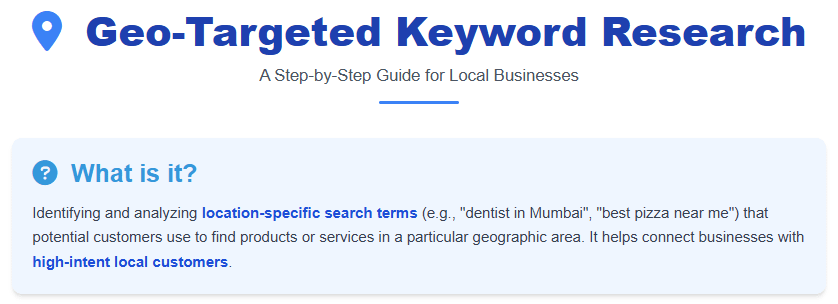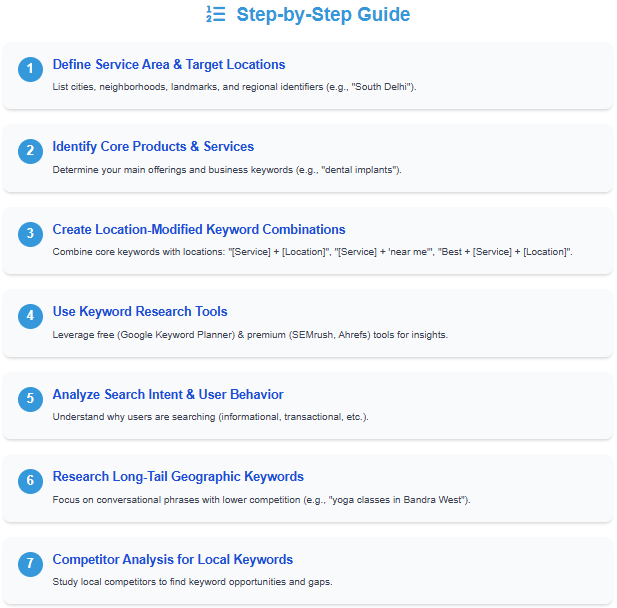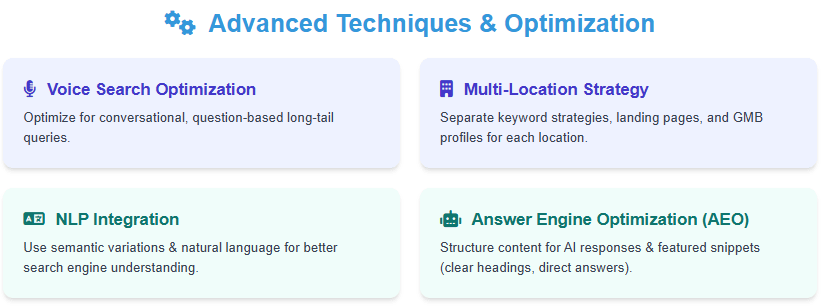In today’s digital landscape, local businesses need to master geo-targeted keyword research to compete effectively in their markets. This comprehensive guide will walk you through the fundamentals of location-based keyword research, helping you connect with customers in your specific geographic area and boost your local search visibility[1][2].
What is Geo-Targeted Keyword Research?
Geo-targeted keyword research is the process of identifying and analyzing location-specific search terms that potential customers use when looking for products or services in a particular geographic area[1][2]. Unlike traditional keyword research that focuses on broad, general terms, geo-targeted research emphasizes keywords that include location modifiers such as city names, neighborhoods, or regional identifiers[3].
These geographic keywords help businesses appear in local search results when customers search for terms like “dentist in Mumbai” or “best pizza near me”[4]. The power of geo-targeting lies in its ability to connect businesses with high-intent local customers who are more likely to convert into actual sales[5].

Why Geo-Targeted Keywords Matter for Local Businesses
Higher Conversion Rates
Location-based keywords typically have higher conversion rates because they capture users with strong local intent[3]. When someone searches for “emergency plumber in Delhi,” they’re actively seeking immediate service in their area, making them more likely to contact a business and make a purchase[5].
Reduced Competition
Geographic modifiers help businesses compete in smaller, more manageable markets rather than against national competitors[3]. A local bakery targeting “wedding cakes in Pune” faces less competition than one trying to rank for the broad term “wedding cakes”[1].
Better User Experience
Geo-specific searches deliver more relevant results to users, improving their overall experience[3]. Search engines reward this relevance by prioritizing local results for location-based queries[6].

Step-by-Step Guide to Geo-Targeted Keyword Research
Step 1: Define Your Service Area and Target Locations
Start by clearly identifying the geographic areas you want to target[7]. Consider:
- Primary service areas: Where do most of your customers come from?
- Secondary markets: Adjacent areas with growth potential
- Neighborhood-level targeting: Specific districts or localities within cities[1]
Create a comprehensive list that includes:
- City names
- Neighborhood names
- Landmark-based locations
- Regional identifiers[4]
Step 2: Identify Your Core Products and Services
Before adding location modifiers, establish your core business keywords[7]. Review your:
- Google Business Profile categories
- Main products or services offered
- Customer pain points you solve
- Industry-specific terminology[8]
For example, a dental practice might focus on: “dental implants,” “teeth whitening,” “emergency dentist,” and “pediatric dentistry”[7].
Step 3: Create Location-Modified Keyword Combinations
Combine your core keywords with location modifiers using these proven formulas[2][9]:
Basic Formula: [Service/Product] + [Location]
- “hair salon downtown Mumbai”
- “car repair South Delhi”
“Near Me” Variations: [Service/Product] + “near me”
- “coffee shop near me”
- “urgent care near me”[9]
Best/Top Modifiers: “Best” + [Service/Product] + [Location]
- “best Italian restaurant Brooklyn”
- “top dentist in Chennai”[9]
Problem-Solution Format: [Problem] + [Solution] + [Location]
- “broken AC repair Phoenix”
- “emergency locksmith Austin”[9]
Step 4: Use Keyword Research Tools for Local Insights
Leverage both free and paid tools to expand your keyword list and gather important metrics[8][10]:
Free Tools:
- Google Keyword Planner: Set location filters to find geo-specific keywords[11]
- Google Autocomplete: Type your keywords and observe location-based suggestions[12]
- AnswerThePublic: Discover question-based local keywords[10]
- Google Trends: Analyze regional search interest[8]
Premium Tools:
- SEMrush: Comprehensive local keyword analysis with competition data[13]
- Ahrefs: Location-specific keyword difficulty and search volume[11]
- KWFinder: Specializes in long-tail local keywords with low competition[14]
Step 5: Analyze Search Intent and User Behavior
Understanding search intent is crucial for effective geo-targeting[15][16]. Classify your keywords by intent:
Informational Intent: “how to find dentist in Bangalore”
Navigational Intent: “directions to Starbucks Mumbai”
Transactional Intent: “book appointment dentist Chennai”
Commercial Investigation: “best restaurants near me reviews”[2]
Step 6: Research Long-Tail Geographic Keywords
Long-tail keywords with location modifiers often have lower competition and higher conversion rates[12]. Focus on:
- Conversational phrases: “where can I find organic food in Pune”
- Voice search optimization: Natural language patterns people use when speaking[6]
- Specific neighborhood targeting: “yoga classes in Bandra West”[1]
Step 7: Competitor Analysis for Local Keywords
Study your local competitors to identify keyword opportunities[11]:

Advanced Geo-Targeting Techniques
Voice Search Optimization
With the rise of voice search, optimize for conversational queries[6][18]:
- Include natural language patterns
- Focus on question-based keywords
- Use long-tail phrases that match how people speak[15]
Multi-Location Keyword Strategy
For businesses with multiple locations, create separate keyword strategies for each area[17]:
- Develop location-specific landing pages
- Use distinct Google Business Profiles for each location
- Implement schema markup for multiple locations[17]
Seasonal and Event-Based Keywords
Incorporate time-sensitive geographic keywords[3]:
- “Christmas decorations Mumbai”
- “Diwali catering services Delhi”
- “monsoon car service Chennai”
Optimizing Content for NLP and AEO
Natural Language Processing Integration
Modern search engines use NLP to better understand user intent[19][20]. Optimize your content by:
- Using semantic keyword variations
- Including entity relationships (connecting your business to related local concepts)
- Writing in natural, conversational language[19]
Answer Engine Optimization (AEO)
Structure your content to appear in AI-generated responses and featured snippets[6][15]:

Common Mistakes to Avoid
Keyword Stuffing
Avoid over-optimization by naturally incorporating geo-targeted keywords into your content[1]. Search engines can detect and penalize excessive keyword repetition[3].
Ignoring Mobile Search
Mobile optimization is crucial for local search success[13]. Ensure your website loads quickly and provides a good user experience on mobile devices[18].
Inconsistent NAP Information
Maintain consistent Name, Address, and Phone number information across all online listings and directories[17][13].
Measuring Success and Monitoring Performance
Track your geo-targeted keyword performance using:
- Google Analytics: Monitor local organic traffic and conversions
- Google Search Console: Track keyword rankings and click-through rates
- Local ranking tools: Monitor position in local search results[17]
- Foot traffic analysis: Measure offline conversions from online searches[21]
Tools and Resources for Implementation
Essential Free Tools
- Google Keyword Planner: Location-based keyword discovery[11]
- Google Business Profile: Local search optimization[21]
- Google Search Console: Performance monitoring[8]
- AnswerThePublic: Question-based keyword discovery[10]
Premium Solutions
- SEMrush: Comprehensive local SEO toolkit[13]
- Ahrefs: Advanced competitor analysis[11]
- LocalFalcon: Specialized local keyword research[7]
- BrightLocal: Local SEO performance tracking[17]
Getting Started: Your Action Plan
- Audit your current keyword strategy – Identify gaps in geo-targeting
- Define your service areas – Create comprehensive location lists
- Research core business keywords – Focus on high-conversion terms
- Build location-modified variations – Use proven keyword formulas
- Create optimized content – Implement findings across your website
- Monitor and adjust – Regularly review performance and refine strategy[7]

Conclusion
Geo-targeted keyword research is essential for local businesses seeking to improve their search visibility and connect with nearby customers. By following this step-by-step guide and incorporating NLP principles and AEO optimization, you can create a robust local SEO strategy that drives more qualified traffic and increases conversions[21][1].
Remember that geo-targeting is an ongoing process requiring regular monitoring and refinement. As search engines continue to evolve and user behavior changes, staying updated with the latest local SEO best practices will ensure your business maintains its competitive edge in local search results[13].
Start implementing these techniques today, and watch your local search visibility improve as you connect with more customers in your target geographic areas. The investment in proper geo-targeted keyword research will pay dividends through increased local traffic, higher conversion rates, and sustainable business growth[5][13].
Frequently Asked Questions (FAQs)
1. What is geo-targeted keyword research, and why does it matter for my local business?
Geo-targeted keyword research identifies search terms specific to a location (like a city, neighborhood, or region). It helps local businesses connect with customers searching for products or services in their area, leading to higher conversion rates and reduced competition from national or global brands.
2. How do I find the right geo-targeted keywords for my business?
Start by listing your service areas and core offerings. Then use keyword tools like Google Keyword Planner, Google Autocomplete, and location filters to generate keyword ideas that combine your services with your target locations (e.g., “plumber in Ghaziabad”). Analyze competitors and use long-tail and conversational phrases for better results.
3. How can I optimize my content for both search engines and answer engines (AEO)?
Structure your pages with clear, question-based headings and provide direct, concise answers. Use natural language and semantic keyword variations, and include structured data markup (like schema). Adding FAQ sections also increases your chances of appearing in featured snippets and AI-generated responses.
4. What are the most common mistakes to avoid in geo-targeted keyword research?
Avoid keyword stuffing, inconsistent business information (Name, Address, Phone), and ignoring the importance of mobile optimization. Also, don’t neglect regular performance monitoring and updating your strategy as search trends and user behaviour evolve.
Citations
- https://www.networksolutions.com/blog/geo-targeted-keywords-get-more-customers/
- https://neilpatel.com/blog/local-keyword-research/
- https://thatware.co/geographic-modifiers/
- https://www.web.com/blog/geo-targeted-keywords-get-more-customers/
- https://www.insegment.com/knowledge-base/search-engine-optimization/geotargeting-guide/
- https://www.youngurbanproject.com/answer-engine-optimization/
- https://www.localfalcon.com/blog/how-to-do-local-keyword-research-a-stepbystep-guide
- https://www.semrush.com/blog/local-keyword-research/
- https://www.youtube.com/watch?v=OOC4AE82964
- https://elatre.com/top-10-free-keyword-research-tools/
- https://www.geoplugin.com/resources/geo-keywords-how-to-find-the-right-ones/
- https://finprov.com/how-to-do-local-seo-keyword-research/
- https://content-whale.com/us/blog/proven-local-seo-tips-2024/
- https://mangools.com/kwfinder/
- https://surferseo.com/blog/answer-engine-optimization/
- https://www.airops.com/blog/aeo-answer-engine-optimization
- https://textuar.com/blog/local-seo-keyword-research/
- https://www.linkedin.com/pulse/what-answer-engine-optimization-guide-aeo-powered-growth-gajura-gzlee
- https://www.pageoptimizer.pro/blog/how-to-research-nlp-keywords
- https://www.algolia.com/blog/ai/advanced-keyword-search-is-built-upon-natural-language-processing-nlp




